Our Reading by Carl Van Vechten Identifies Him as an Audience Member Who
| Carl Van Vechten | |
|---|---|
 Self-portrait (1933) | |
| Born | (1880-06-17)June 17, 1880 Cedar Rapids, Iowa, U.S. |
| Died | December 21, 1964(1964-12-21) (aged 84) New York Urban center, New York, U.Southward. |
| Teaching | Washington Loftier Schoolhouse |
| Alma mater | University of Chicago |
| Occupation | Photographer |
| Spouse(s) | Anna Snyder (g. 1907–1912) Fania Marinoff (m. 1914–1964) |
Carl Van Vechten (June 17, 1880 – December 21, 1964) was an American writer and creative photographer who was a patron of the Harlem Renaissance and the literary executor of Gertrude Stein.[i] He gained fame as a author, and notoriety as well, for his 1926 novel Nigger Heaven. In his afterwards years, he took upwards photography and took many portraits of notable people. Although he was married to women for almost of his adult life, Van Vechten engaged in numerous homosexual affairs over his lifetime.
Life and career [edit]
Born in Cedar Rapids, Iowa, he was the youngest child of Charles Duane Van Vechten and Ada Amanda Van Vechten (née Fitch).[2] : 14 [3] Both of his parents were well educated. His father was a wealthy and prominent broker. His mother established the Cedar Rapids Public Library and had smashing musical talent.[four] As a child, Van Vechten developed a passion for music and theatre.[5] He graduated from Washington High School in 1898.[six]
Afterward loftier schoolhouse, Van Vechten was eager to take the next steps in his life, but establish it difficult to pursue his passions in Iowa. He described his hometown as "that unloved town". To advance his didactics, he decided in 1899 to written report at the University of Chicago,[7] [5] where he studied a variety of topics including music, fine art and opera. Equally a pupil, he became increasingly interested in writing and wrote for the college newspaper, the University of Chicago Weekly.
After graduating from higher in 1903, Van Vechten accepted a job as a columnist for the Chicago American. In his column "The Chaperone", Van Vechten covered many different topics through a style of semi-autobiographical gossip and criticism.[5] During his fourth dimension with the Chicago American, he was occasionally asked to include photographs with his column. This was the showtime time he was thought to have experimented with photography, which later became one of his greatest passions.[v] Van Vechten was fired from his position with the Chicago American because of what was described equally an elaborate and complicated way of writing. Some described his contributions to the paper as "lowering the tone of the Hearst papers".[4] In 1906, he moved to New York City. He was hired as the assistant music critic at The New York Times.[viii] His involvement in opera had him accept a leave of absenteeism from the paper in 1907 to travel to Europe and explore opera.[ane]
While in England, he married Anna Snyder, his long-time friend from Cedar Rapids. He returned to his task at The New York Times in 1909, where he became the first American critic of modern dance. Under the leadership of Van Vechten'southward social mentor Mabel Dodge Luhan, he became engrossed in avant-garde art. This was an innovative type of fine art which explores new styles or subject matters and is thought to exist well ahead of other art in terms of technique, subject thing, and awarding. He began to frequently nourish groundbreaking musical premieres at the time when Isadora Duncan, Anna Pavlova, and Loie Fuller were performing in New York City. He also attended premieres in Paris where he met American writer and poet Gertrude Stein in 1913.[four] He became a devoted friend and champion of Stein and was considered to be 1 of Stein's about enthusiastic fans.[9] They continued corresponding for the rest of Stein'south life, and, at her death, she appointed Van Vechten her literary executor; he helped to bring into print her unpublished writings.[2] : 306 A drove of the letters between Van Vechten and Stein has been published.[10]
Van Vechten wrote a piece called "How to Read Gertrude Stein" for the arts magazine The Trend. In his slice, Van Vechten attempted to demystify Stein and bring clarity to her works. Van Vechten came to the conclusion that Stein can exist best understood when 1 has been guided through her work by an "expert insider". He writes that "special writers crave special readers".[xi]
The marriage to Anna Snyder concluded in divorce in 1912, and he wed actress Fania Marinoff in 1914.[12] Van Vechten and Marinoff were known for ignoring the social separation of races during the times and for inviting blacks to their home for social gatherings. They were too known to attend public gatherings for black people and to visit black friends in their homes.

Van Vechten is depicted in Asbury Park S, 1920 painting by Jazz Age creative person Florine Stettheimer. Among a summertime crowd in Asbury Park, the artist is under a dark-green parasol, several of her friends are also recognizable. Van Vechten stands on the elevated structure left (black suit), Avery Hopwood (white conform, right side) talks with a adult female in a yellow dress, and the Swiss painter Paul Thévanaz (red bathing suit) bends over a camera. Artist Marcel Duchamp (pinkish adjust) walks with Van Vechten's married woman, the actress Fania Marinoff. [13]
Although Van Vechten's marriage to his married woman Fania Marinoff lasted for fifty years, they often had arguments about Van Vechten's affairs with men.[9] Van Vechten was known to have romantic and sexual relationships with men, specially Mark Lutz.[8] Lutz (1901–1968) grew upward in Richmond, Virginia, and was introduced to Van Vechten by Hunter Stagg in New York in 1931. Lutz was a model for some of Van Vechten's primeval experiments with photography. The friendship lasted until Van Vechten's death. At Lutz's death, equally per his wishes, the correspondence with Van Vechten, amounting to 10,000 messages, was destroyed. Lutz donated his collection of Van Vechten'due south photographs to the Philadelphia Museum of Art.[14]
Several books of Van Vechten's essays on diverse subjects, such as music and literature, were published betwixt 1915 and 1920, and Van Vechten too served as an informal scout for the newly formed Alfred A. Knopf.[15] Betwixt 1922 and 1930 Knopf published seven novels by him, starting with Peter Whiffle: His Life and Works and catastrophe with Parties. [16] His sexuality is most clearly reflected in his intensely homoerotic portraits of working-form men.
As an appreciator of the arts, Van Vechten was extremely intrigued by the explosion of creativity which was occurring in Harlem. He was fatigued towards the tolerance of Harlem order and the excitement it generated amongst black writers and artists. He besides felt most accepted there equally a gay man.[17] Van Vechten promoted many of the major figures of the Harlem Renaissance, including Paul Robeson, Langston Hughes, Ethel Waters, Richard Wright, Zora Neale Hurston and Wallace Thurman. Van Vechten'southward controversial novel Nigger Heaven [7] was published in 1926. His essay "Negro Blues Singers" was published in Vanity Fair in 1926. Biographer Edward White suggests Van Vechten was convinced that negro culture was the essence of America.[2]

Van Vechten House and Studio, Manhattan, New York City, 2017
Van Vechten played a critical function in the Harlem Renaissance and helped to bring greater clarity to the African-American movement. Nevertheless, for a long time he was also seen every bit a very controversial effigy. In Van Vechten's early writings, he claimed that black people were born to exist entertainers and sexually "gratuitous". In other words, he believed that black people should be free to explore their sexuality and singers should follow their natural talents such equally jazz, spirituals and blues.[17] Van Vechten wrote virtually his experiences of attending a Bessie Smith concert at the Orpheum Theatre in Newark, New Jersey, in 1925.[18]
In Harlem, Van Vechten ofttimes attended opera and cabarets. He was credited for the surge in white interest in Harlem nightlife and culture as well as involved in helping well-respected writers such as Langston Hughes and Nella Larsen to find publishers for their early works.[xix]
In 2001, Emily Bernard published "Remember Me to Harlem". This was a collection of messages which documented the long friendship between Van Vechten and Langston Hughes, who publicly dedicated Nigger Sky.[17] Bernard's book Carl Van Vechten and the Harlem Renaissance: A Portrait in Black and White explores the messy and uncomfortable realities of race, and the complicated tangle of black and white in America.[17]
His older brother Ralph Van Vechten died on June 28, 1927; when Ralph'due south widow Fannie died in 1928, Van Vechten inherited $ane one thousand thousand invested in a trust fund, which was unaffected by the stock market crash of 1929 and provided fiscal support for Carl and Fania.[2] : 242–244 [xx]
By the start of the 1930s and at the historic period of 50, Van Vechten was finished with writing and took upward photography, using his flat at 150 W 55th Street as a studio, where he photographed many notable people.[21] [22]
After the 1930s Van Vechten published footling writing, though he continued writing messages to many correspondents.
Van Vechten died in 1964 at the age of 84 in New York Metropolis. His ashes were scattered over the Shakespeare garden in Central Park.[23] He was the subject of a 1968 biography past Bruce Kellner, Carl Van Vechten and the Irreverent Decades,[24] as well equally Edward White's 2014 biography, The Tastemaker: Carl Van Vechten and the Birth of Modern America.[two]
Works [edit]
At age 40, Van Vechten wrote the volume Peter Whiffle, which established him as a respected novelist. This novel was recognized every bit contemporary and an important piece of work to the collection of Harlem Renaissance history. In his novel, autobiographical facts were arranged into a fictional grade. In improver to Peter Whiffle, Van Vechten wrote several other novels. Ane is The Tattooed Countess, a bearded manipulation of his memories of growing up in Cedar Rapids.[9] His book the Tiger in the Firm explores the quirks and qualities of Van Vechten'due south most beloved animate being, the cat.[25]
One of his more than controversial novels, Nigger Heaven, was received with both controversy and praise. Van Vechten called this book "my Negro novel". He intended for this novel to depict how African Americans were living in Harlem and not near the suffering of blacks in the South who were dealing with racism and lynchings. Although many encouraged Van Vechten to reconsider giving his novel such a controversial name, he could not resist having an incendiary title. Some worried that his championship would have abroad from the content of the book. In one alphabetic character, his father wrote to him, "Whatever yous may be compelled to say in the book," he wrote, "your present title will not be understood & I experience certain you lot should change it."[26]
Many black readers were divided over how the novel depicted African Americans. Some felt that it depicted black people as "alien and foreign", and others valued the novel for its representation of African Americans as everyday people, with complexity and flaws just like typical White characters. The novel'southward supporters included Nella Larsen, Langston Hughes and Gertrude Stein, who all defended the novel for bringing Harlem order and racial issues to the forefront of America.[27]
His supporters too sent him letters to voice their opinions of the novel. Alain Locke sent Van Vechten a letter from Berlin citing his novel Nigger Sky and the excitement surrounding its release every bit his primary reason for making an imminent return home. Gertrude Stein sent Van Vechten a letter from French republic writing that the novel was the best thing he had ever written. Stein also played an important office in the development of the novel.[27]
Well-known critics of this novel included African-American scholar W. E. B. Du Bois and black novelist Wallace Thurman. Du Bois dismissed the novel every bit "cheap melodrama".[17] Decades after the book was published, literary critic and scholar Ralph Ellison remembered Van Vechten as a bad influence, an unpleasant character who "introduced a note of decadence into Afro-American literary matters which was not needed". In 1981, David Levering Lewis, historian and writer of a classic report of the Harlem Renaissance, called Nigger Heaven a "colossal fraud", a seemingly uplifting book with a message that was overshadowed by "the throb of the tom-tom". He viewed Van Vechten as beingness driven by "a mixture of capitalism and patronizing sympathy".[26]
- Music After the Great War (1915)
- Music and Bad Manners (1916)
- Interpreters and Interpretations (1917)
- The Merry-Go-Round (1918)
- The Music of Spain (1918)
- In the Garret (1919)
- The Tiger in the House (1920)
- Lords of the Housetops (1921)
- Peter Whiffle (1922)
- The Blind Bow-Boy (1923)
- The Tattooed Countess (1924)
- Cherry-red (1925)
- Firecrackers. A Realistic Novel (1925)
- Excavations (1926)
- Nigger Heaven (1926)
- Spider Male child (1928)
- Parties (1930)
- Feathers (1930)
- Sacred and Profane Memories (1932)
Posthumous
- The Dance Writings of Carl Van Vechten (1974)
Source: A bibliography of the writings of Carl Van Vechten at the HathiTrust Digital Library
Archives and museum collections [edit]
Most of Van Vechten'south personal papers are held by the Beinecke Rare Book & Manuscript Library at Yale University. The Beinecke Library also holds a collection titled "Living Portraits: Carl Van Vechten's Colour Photographs of African Americans, 1939–1964", a drove of ane,884 color Kodachrome slides.[28]

Saul Mauriber, after a photo of Salvador Dalí by Halsman (1944), past Van Vechten
The Library of Congress has a drove of approximately i,400 photographs which it caused in 1966 from Saul Mauriber (May 21, 1915 – Feb 12, 2003). There is as well a drove of Van Vechten'due south photographs in the Prentiss Taylor collection in the Smithsonian's Archives of American Fine art, and a Van Vechten collection at Fisk University. The Museum of the City of New York'south collection includes 2,174 of Carl Van Vechten's photographs. Brandeis Academy's department of Archives & Special Collections holds 1,689 Carl Van Vechten portraits.[29] Van Vechten also donated materials to Fisk University to form the George Gershwin Memorial Collection of Music and Musical Literature.[2] : 284
The Philadelphia Museum of Fine art currently holds one of the largest drove of photographs by Van Vechten in the United States. The collection began in 1949 when Van Vechten made a gift of threescore of his photographs to the museum. In 1965, Marker Lutz made a gift to the museum of over 12,000 photographs by Van Vechten from his personal collection. Included in the collection are images from extensive portrait sessions with figures of the Harlem Renaissance such as Langston Hughes, Ella Fitzgerald, Billie Vacation, Zora Neale Hurston, and Cab Calloway; artists such as Marcel Duchamp, Henri Matisse, Joan Miró, and Frida Kahlo; and countless other actors, musicians, and cultural figures. Also included in the Mark Lutz souvenir is an all-encompassing torso of photographs Van Vechten took at the 1939 New York World's Off-white also equally a large number of photographs depicting scenes beyond Western Europe and Northern Africa taken during Van Vechten'due south travels in 1935–1936.[30]
In 1980, concerned that Van Vechten's fragile 35 mm nitrate negatives were fast deteriorating, lensman Richard Benson, in conjunction with the Eakins Press Foundation, transformed 50 of the portraits into handmade gravure prints. The album 'O, Write My Name': American Portraits, Harlem Heroes was completed in 1983. That twelvemonth, the National Endowment for the Arts transferred the Eakins Press Foundation's epitome albums to the permanent collection of the Smithsonian American Art Museum.[31]
The National Portrait Gallery, London, holds 17 of Van Vechten's portraits of leading creative talents of his era.[32]
More than 3,000 Van Vechten portraits, nearly of which come from the Library of Congress collection, are included in Wikimedia Commons. His public domain photographs illustrate countless Wikipedia entries on mid-century (mostly American) notables. Meet examples in the gallery below.
- Carl Van Vechten Papers. Yale Drove of American Literature, Beinecke Rare Book and Manuscript Library.
- Carl Van Vechten Papers Relating to African American Arts and Letters. James Weldon Johnson Collection in the Yale Collection of American Literature, Beinecke Rare Book and Manuscript Library.
- Guide to the Carl Van Vechten papers, 1833–1965. Manuscripts and Archives, New York Public Library.
- Carl Van Vechten drove of papers, 1911–1964. Berg Collection of English and American Literature, New York Public Library.
- Carl Van Vechten theatre photographs, 1932–1943, held by the Billy Rose Theatre Division at the New York Public Library for the Performing Arts
- Carl Van Vechten photographs, 1932–1964 at Brandeis University's Archives & Special Collections, contains one,689 Van Vechten portraits.
- Images by Carl Van Vechten in the Collections of the Museum of the City of New York [ permanent dead link ]
- Living Portraits: Carl Van Vechten's Colour Photographs of African Americans, 1939–1964, Beinecke Rare Book and Manuscript Library at Yale University, features a searchable database of 1,884 rare color Kodachrome slides
- Portraits by Carl Van Vechten at the National Portrait Gallery, London
- Artistic Americans: Portraits by Carl Van Vechten at the Library of Congress
- Carl Van Vechten'due south Portraits from the collection of the Beinecke Rare Book and Manuscript Library at Yale Academy: over 9,000 blackness-and-white prints
- Postcards from Manhattan: The Portrait Photography of Carl Van Vechten at Marquette Academy: hundreds of portrait postcards sent by Van Vechten to Wisconsin artist Karl Priebe from 1946 to 1956.
- Guide to the Carl Van Vechten Photograph Collection 1932-1956 at the University of Chicago Special Collections Research Center
Gallery [edit]
References [edit]
Notes [edit]
- ^ a b "Portraits by Carl Van Vechten – Carl Van Vechten Biography – (American Memory from the Library of Congress)". Memory.loc.gov. Retrieved March ix, 2010.
- ^ a b c d e f White, Edward (2014), The Tastemaker: Carl Van Vechten and the Birth of Modern America, New York: Farrar, Straus and Giroux, ISBN978-0-374-20157-ix
- ^ "Ada Amanda Fitch Van Vechten (1841-1905) - Find a grave". world wide web.findagrave.com . Retrieved May 23, 2020.
- ^ a b c "Van Vechten, Carl – The Biographical Lexicon of Iowa - The University of Iowa". uipress.lib.uiowa.edu . Retrieved May 23, 2018.
- ^ a b c d "Van Vechten Drove – Carl Van Vechten Biography and Chronology". Loc.gov. 1932. Retrieved May 23, 2018.
- ^ "Carl Van Vechten's Camera Documented Personalities". Cedar Rapids Gazette. March ten, 1971. Retrieved November 17, 2012. [ permanent expressionless link ]
- ^ a b "Carl Van Vechten Biography". Biography.com. December 21, 1964. Retrieved March ix, 2010. [ permanent dead link ]
- ^ a b Sanneh, Kelefa (Feb 17, 2014). "White Mischief: The Passions of Carl Van Vechten". The New Yorker.
- ^ a b c "Van Vechten, Carl – The Biographical Lexicon of Iowa - The Academy of Iowa". uipress.lib.uiowa.edu . Retrieved May 24, 2018.
- ^ "Van Vechten Collection – Carl Van Vechten Biography and Chronology". loc.gov. 1932. Retrieved May 24, 2018.
- ^ White, Edward (Feb 18, 2014). The Tastemaker: Carl Van Vechten and the Birth of Modern America (Showtime ed.). New York. ISBN9780374201579. OCLC 846545238.
- ^ "Carl Van Vechten'south Biography on nybooks.com". Retrieved July 10, 2012.
- ^ McBride, Henry, Florine Stettheimer, The Museum of Mod Art 1946.
- ^ The Letters of Gertrude Stein and Carl Van Vechten, 1913–1946. Columbia Academy Press. 2013. p. 310. ISBN9780231063098 . Retrieved January 13, 2018.
- ^ Claridge, Laura (2016). The Lady with the Borzoi: Blanche Knopf, Literary Tastemaker Extraordinaire (Start ed.). New York: Farrar, Straus and Giroux. p. 41. ISBN9780374114251. OCLC 908176194.
- ^ "Carl Van Vechten Facts, information, pictures | Encyclopedia.com manufactures almost Carl Van Vechten". Encyclopedia.com. Retrieved June 17, 2012.
- ^ a b c d e Bernard, Emily (2012). Carl Van Vechten and the Harlem Renaissance: A Portrait in Black and White . New Haven [Conn.]: Yale Academy Press. ISBN9780300183290. OCLC 784957824.
- ^ Oakley, Giles (1997). The Devil's Music . Da Capo Press. p. 106. ISBN978-0-306-80743-5.
- ^ Van Vechten, Carl (2006). The tiger in the house. New York: New York Review Books. ISBN9781590172230. OCLC 76142159.
- ^ Smalls, James (2006), The Homoerotic Photography of Carl Van Vechten: Public Face, Private Thoughts, Philadelphia: Temple University Press, p. 24, ISBN1-59213-305-3
- ^ "Carl Van Vechten: Biography from". Answers.com. December 21, 1964. Retrieved March ix, 2010.
- ^ "Prints & Photographs Online Itemize – Van Vechten Collection – Biography". Lcweb2.loc.gov. Retrieved March 9, 2010.
- ^ Wilson, Scott. Resting Places: The Burial Sites of More Than 14,000 Famous Persons, 3d ed.: ii (Kindle Location 48447). McFarland & Company, Inc., Publishers. Kindle Edition
- ^ Kellner, B., Carl Van Vechten and the Irreverent Decades (Norman: University of Oklahoma Printing, 1968). OCLC 292311
- ^ Van Vechten, Carl (2006). The tiger in the house. New York: New York Review Books. ISBN9781590172230. OCLC 76142159.
- ^ a b "White Mischief". The New Yorker . Retrieved May 24, 2018.
- ^ a b White, Edward (February eighteen, 2014). The Tastemaker: Carl Van Vechten and the Nascency of Modern America (First ed.). New York. ISBN9780374201579. OCLC 846545238.
- ^ Living Portraits: Carl Van Vechten's Colour Photographs Of African Americans, 1939–196 Archived September 25, 2011, at the Wayback Machine. Beinecke Rare Book and Manuscript Library at Yale University. Retrieved July eight, 2009.
- ^ "Carl Van Vechten photographs". Robert D. Farber University Archives & Special Collections Department. Brandeis University. Retrieved August 25, 2016.
- ^ "Philadelphia Museum of Fine art – Collections : Search Collections". philamuseum.org . Retrieved Baronial 30, 2019.
- ^ "Harlem Heroes: Photographs past Carl Van Vechten". Exhibitions – Smithsonian American Art Museum. Smithsonian Institution. Retrieved August 25, 2016.
- ^ "Carl Van Vechten – National Portrait Gallery". Npg.org.united kingdom of great britain and northern ireland.
Bibliography [edit]
- Bird, Rudolph P. (ed.) (1997). Generations in Blackness and White: Photographs of Carl Van Vechten from the James Weldon Johnson Memorial Collection, Academy of Georgia Press. ISBN 0820319449
- Kellner, Bruce (1968). Carl Van Vechten and the Irreverent Decades. Norman: University of Oklahoma Printing. ISBN 0-8061-0808-8
- Kellner, Bruce (ed.) (1980). A Bibliography of the Work of Carl Van Vechten. Westport: Greenwood Printing. ISBN 0-313-20767-four
- Kellner, Bruce (ed.) (1987). Letters of Carl Van Vechten. New Haven: Yale University Printing. ISBN 0-300-03907-7
- Smalls, James (2006). The Homoerotic Photography of Carl Van Vechten: Public Face up, Private Thoughts. Philadelphia: Temple Academy Press. ISBN one-59213-305-3
- White, Edward (2014). The Tastemaker: Carl Van Vechten and the Nativity of Modern America. New York: Farrar, Straus and Giroux. ISBN 978-0-374-20157-9
- Hurston, Zora Neale (1984). Dust Tracks on a Road: An Autobiography. University of Illinois Press. ISBN 0-252-01047-7
External links [edit]
- Works by Carl Van Vechten at Project Gutenberg
- Works by Carl Van Vechten at Faded Page (Canada)
- Works past or about Carl Van Vechten at Net Archive
- Works past Carl Van Vechten at LibriVox (public domain audiobooks)

- Improvident Crowd: Carl Van Vechten's Portraits of Women, Beinecke Rare Book and Manuscript Library at Yale University
- Booknotes interview with Emily Bernard on Recollect Me to Harlem: The Messages of Langston Hughes and Carl Van Vechten, 1925–1964, Apr 22, 2001.
- Stuart A. Rose Manuscript, Archives, and Rare Book Library, Emory Academy: "Carl Van Vechten: American Portraitist" showroom materials, 1992 (curated by Deborah Willis)
- Carl Van Vechten theatre photographs, 1932-1943, held by the Billy Rose Theatre Division, New York Public Library for the Performing Arts
Source: https://en.wikipedia.org/wiki/Carl_Van_Vechten
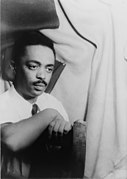

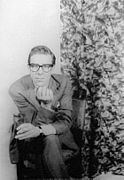
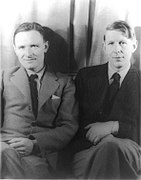




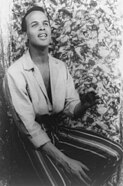



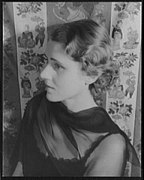








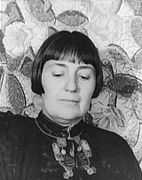

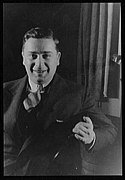
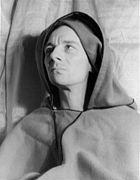


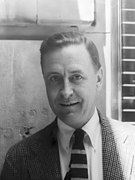






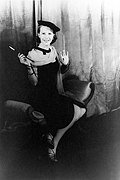
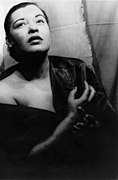







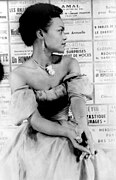
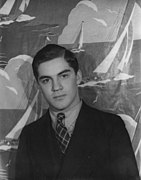


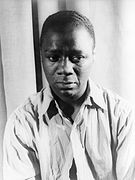




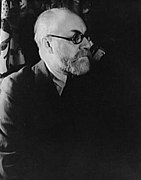



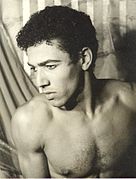







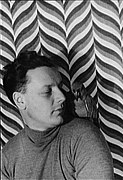




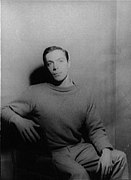
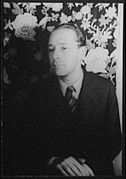



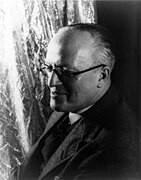
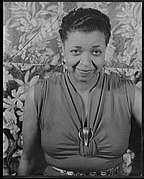




0 Response to "Our Reading by Carl Van Vechten Identifies Him as an Audience Member Who"
Post a Comment